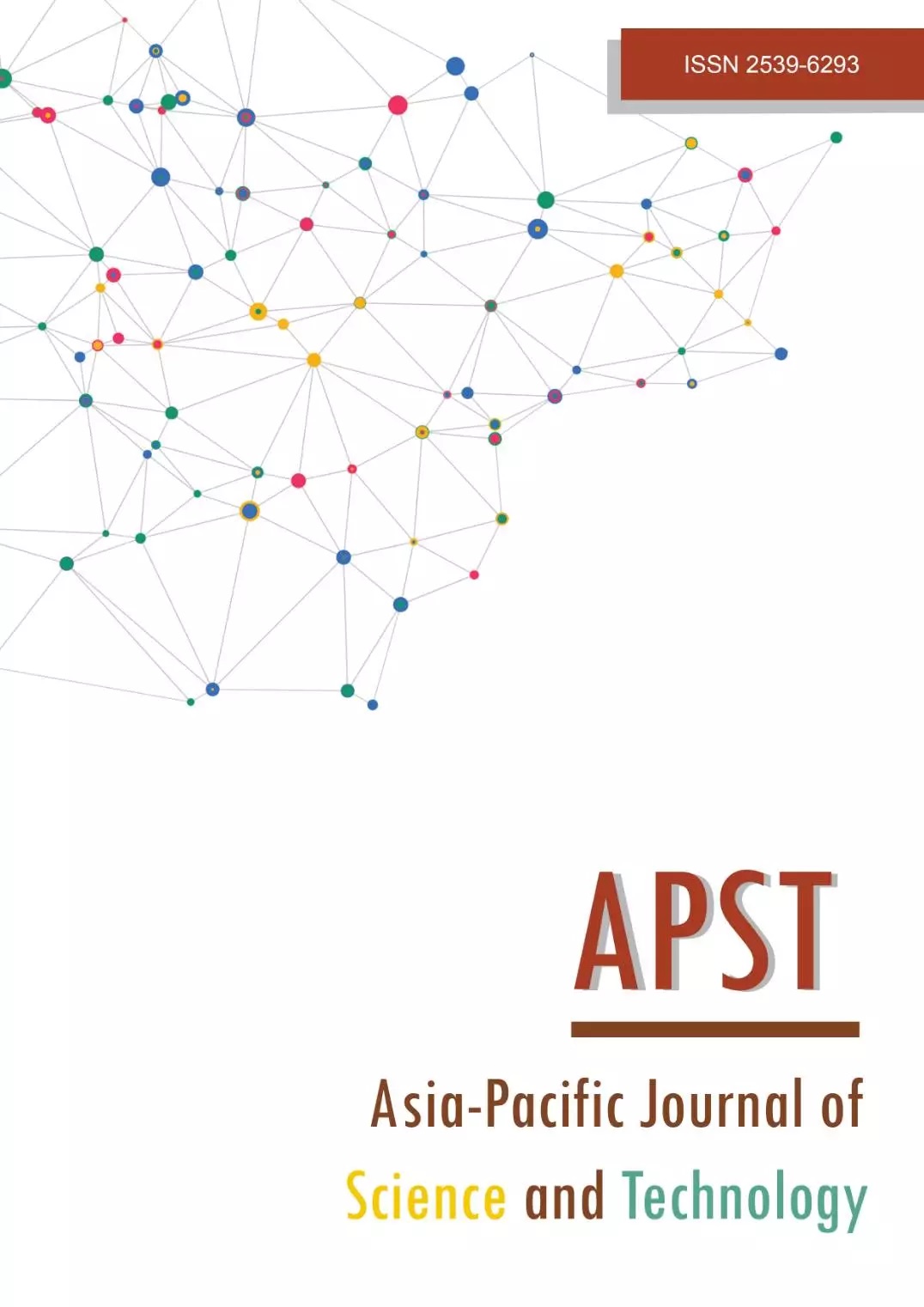Assessment of landslide susceptibility using geoinformatics and a frequency ratio model: a case study of Mae Tha River Watershed in Northern Thailand
Main Article Content
Abstract
A landslide is one form of geological hazard that causes socioeconomic impacts, geo-environmental changes, and damage to human lives and properties globally. The Mae Tha River watershed, located in a complex faulted- and high-slope terrain, is considered to be especially susceptible to occurrences of landslides. This study aimed to evaluate landslide susceptibility across this unique watershed using the integration of geoinformatics and a statistical frequency ratio model. Across the watershed, 67 landslide scars in the mountainous region were observed and examined for use as landslide inventory data. The landslide inventory data were combined with causative factors to produce a landslide susceptibility index as well as zones. The analysis revealed that approximately 36% of the entire watershed was highly susceptible to landslides, particularly the high terrain in the watershed's east and west. The accuracy, reliability, and predictability of the landslide susceptibility data were validated using the values of the area under the receiver operating characteristic (ROC) curve analysis (AUC). AUC values between 0.6 and 0.8 indicated that the model's performance in identifying and predicting landslide susceptibility classes was reasonably satisfactory to good. The results suggested that the frequency ratio model was an efficient statistical tool for landslide susceptibility assessment. Effective landslide susceptibility classes can be produced for community planning and mitigation purposes in this watershed as well as other areas with similar conditions.
Article Details

This work is licensed under a Creative Commons Attribution-NonCommercial-NoDerivatives 4.0 International License.
References
Cruden DM. A simple definition of a landslide. Bull Int Assoc Eng Geol. 1991;43:27-29.
Hung LQ, Van NTH, Duc DM, Ha LTC, Son PV, Khanh, NH, et al. Landslide susceptibility mapping by combining the analytical hierarchy process and weighted linear combination methods: a case study in the upper Lo River catchment (Vietnam). Landslides. 2016;13:1285-1301.
Ilia I, Tsangaratos P. Applying weight of evidence method and sensitivity analysis to produce a landslide susceptibility map. Landslides. 2016;13(2):379-397.
Pradhan B, Lee S. Delineation of landslide hazard areas on Penang Island, Malaysia, by using frequency, logistic regression, and artificial neural network models. Environ Earth Sci. 2010;60:1037-1054.
Wang Q, Li W, Yan S. GIS based frequency ratio and index of entropy models to landslide susceptibility mapping (Daguan, China). Environ Earth Sci. 2016;75:780.
Sukpinit J, Hemwan, P, Charoenpanyanet A. Landslide susceptibility assessment using frequency ratio
method: a case study in Sakad village, Sakad subdistrict, Pua district, Nan province. BUSCIJ. 2022;27(3):1832-1851.
Lee S, Talib JA. Probabilistic landslide susceptibility and factor effect analysis. Environ Geol. 2005;47:982-990.
Ward TJ, Rhu-Ming L, Simons DB. Mapping landslide hazard in forest watershed. J Geotech Eng-ASCE. 1982;108(2):319-324.
Chinkulkijniwat A, Salee R, Horpibulsuk S, Arulrajah A, Hoy M. Landslide rainfall threshold for landslide warning in Northern Thailand. Geomat Nat Haz Risk. 2022;13(1):2425-2441.
Pailoplee S, Charusiri P. Seismic hazards in Thailand: a compilation and updated probabilistic analysis. Earth Planets Space. 2016;68:98.
Chung CJF, Fabbri AG. Validation of spatial prediction models for landslide hazard mapping. Nat Hazards. 2003;30(3):451-472.
Dai FC, Lee CF. A spatiotemporal probabilistic modelling of storm-indued shallow landsliding using aerial photographs and logistic regression. Earth Surf Proc Land. 2003;28:527-545.
Upper Northern Region Irrigation Hydrology Center. Rainfall data [Internet]. 2016 [cited 2023 Apr 12]. Available from https://www.hydro-1.net/main/3-RAIN.php.
Nakileza BR, Nedala S. Topographic influence on landslides characteristics and implication for risk management in upper Manafwa catchment, Mt Elgon Uganda. Geoenvironmental Disasters. 2020;7:27.
Land Development Department. Soil service [Internet]. 2022 [cited 2023 Apr 12]. Available from https://dinonline.ldd.go.th/#header_top_border.
Park S, Choi C, Kim B, Kim J. Landslide susceptibility mapping using frequency ratio, analytic hierarchy process, logistic regression, and artificial neural network methods at Inje area, Korea. Environ Earth Sci. 2013;68:1443-1464.
Mejia AI, Niemann JD. Identification and characterization of dendritic, parallel, pinnate, rectangular, and trellis networks based on deviations form planform self-similarity. J Geophys Res. 2008;113:F02015.
Liu JG, Mason PJ, Yu E, Wu M-C, Tang C, Huang R, et al. GIS modelling of earthquake damage zones
using satellite remote sensing and DEM Data. Geomorphology. 2012;139-140:518-535.
Nguyen HTT, Doan TM, Tomppo E, McRoberts RE. Land use/land cover mapping using multitemporal
Sentinel-2 imagery and four classification methods-a case study from Dak Nong, Vietnam. Remote Sens. 2020;12(9):1367.
Chen W, Xie X, Wang J, Pradhan B, Hong H, Bui DT, et al. A comparative study of logistic model tree, random forest, and classification and regression tree models for spatial prediction of landslide susceptibility. Catena. 2017;151:147-160.
Kalantar B, Pradhan B, Naghibi SA, Motevalli A, Mansor S. Assessment of the effects of training data selection on the landslide susceptibility mapping: a comparison between support vector machine (SVM), logistic regression (LR) and artificial neural networks (ANN). Geomat Nat Haz Risk. 2017;9(1):49-69.
Mas JF, Filho BS, Pontius RG, Gutierrez MF, Rodrigues H. A suite of tools for ROC analysis of spatial models. ISPRS Int J Geo-Inf. 2013;2(3):869-887.
Yesilnacar E, Topal T. Landslide susceptibility mapping: a comparison of logistic regression and neural networks method in a medium scale study, Hendek region (Turkey). Eng Geol. 2005;79:251-266.
Department of Mineral Resources. Landslide susceptibility map [Internet]. 2022 [cited 2023 Apr 12]. Available from https://data.dmr.go.th/fa_IR/dataset/landslide_susceptibility.


